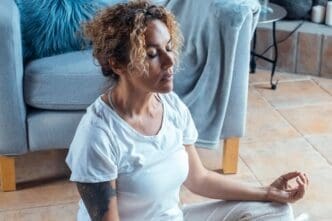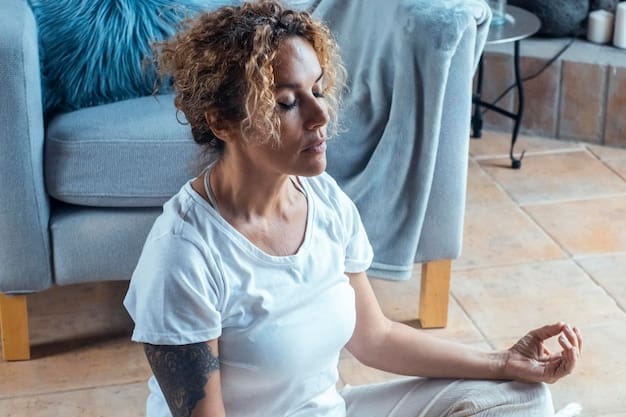When the tell-tale signs of anxiety strike—a racing heart, shallow breath, and a mind spiraling with worry—a powerful and immediate antidote is already within your control. For millions of people, intentional breathing exercises serve as a free, accessible, and scientifically-backed tool to instantly calm the body’s stress response. By consciously changing the pace and depth of your breath, you can directly influence your nervous system, signaling your brain to shift from a state of high alert to one of calm and safety, providing rapid relief anytime, anywhere.
The Science of a Single Breath: How Breathing Calms Anxiety
To understand why a simple breath can be so powerful, we must first look at the body’s internal wiring. Our response to stress is largely managed by the autonomic nervous system, which operates automatically, without our conscious thought.
This system has two main branches that act like a gas pedal and a brake. When you perceive a threat, real or imagined, your body hits the gas.
The “Fight-or-Flight” Response
The sympathetic nervous system is your body’s alarm system, triggering the “fight-or-flight” response. It releases stress hormones like adrenaline and cortisol, causing your heart to pound, your breathing to become shallow and rapid, and your muscles to tense.
This response is essential for survival in a true emergency, but for someone with anxiety, this alarm can be stuck in the “on” position, creating a chronic state of physiological stress.
Activating the “Rest-and-Digest” System
The parasympathetic nervous system is the brake. It promotes the “rest-and-digest” response, which conserves energy and calms the body down after the danger has passed. Deep, slow, intentional breathing is one of the fastest ways to manually engage this system.
When you breathe deeply and slowly, you stimulate a critical component of this system: the vagus nerve. This long nerve runs from the brainstem down to the abdomen, connecting to the heart, lungs, and other vital organs. Stimulating it sends a direct message to your brain that you are safe, effectively overriding the panic signals.
Proven Breathing Techniques for Immediate Relief
While the concept is simple, different techniques can be used to target specific aspects of the anxiety response. Finding one that feels comfortable and effective for you is key. Practice these when you are calm so they become second nature during moments of distress.
Diaphragmatic Breathing (Belly Breathing)
This is the foundation of most relaxation techniques. Many of us, especially when stressed, become “chest breathers,” taking shallow breaths that can worsen anxiety. Diaphragmatic breathing retrains you to use your full lung capacity.
How to Do It:
- Lie on your back or sit comfortably in a chair with your shoulders relaxed.
- Place one hand on your upper chest and the other on your belly, just below your rib cage.
- Inhale slowly through your nose for a count of four, allowing your belly to push your hand out. Keep the hand on your chest as still as possible.
- Exhale slowly through your mouth or nose, feeling your belly fall as you gently contract your abdominal muscles. The hand on your chest should remain relatively still.
This technique ensures you are using your diaphragm, the large muscle at the base of the lungs, to breathe efficiently. This deep breathing pattern maximizes oxygen exchange and is profoundly calming to the nervous system.
Box Breathing (4-4-4-4 Breathing)
Popularized by Navy SEALs for its ability to induce calm and focus under pressure, box breathing is easy to remember and highly effective. The simple, even rhythm helps regulate the autonomic nervous system and distracts the mind from anxious thoughts.
How to Do It:
- Find a comfortable seated position and gently exhale all the air from your lungs.
- Inhale slowly through your nose to a mental count of four.
- Hold your breath for a count of four.
- Exhale slowly and completely through your mouth for a count of four.
- Hold your breath at the end of the exhale for a count of four before beginning again.
Visualize drawing a box as you perform each step. This mental imagery can enhance your focus and deepen the state of relaxation.
The 4-7-8 Breathing Technique
Developed by Dr. Andrew Weil, this technique is often described as a “natural tranquilizer for the nervous system.” The emphasis on a long exhale is particularly effective at activating the parasympathetic response.
How to Do It:
- Sit with your back straight and place the tip of your tongue against the ridge of tissue just behind your upper front teeth. Keep it there for the entire exercise.
- Exhale completely through your mouth, making a whooshing sound.
- Close your mouth and inhale quietly through your nose to a mental count of four.
- Hold your breath for a count of seven.
- Exhale completely through your mouth, making a whoosh sound, for a count of eight.
This completes one breath cycle. Repeat the cycle three more times for a total of four breaths. The held breath allows your body to fully absorb the oxygen, while the extended exhale purges carbon dioxide and profoundly relaxes the body.
Pursed-Lip Breathing
This simple technique is especially helpful for feelings of shortness of breath that often accompany anxiety and panic. It slows your breathing pace, reduces the work of breathing, and provides an immediate sense of control.
How to Do It:
- Relax your neck and shoulders.
- Breathe in slowly through your nose for two counts, keeping your mouth closed.
- Pucker or “purse” your lips as if you were about to whistle or blow out a candle.
- Breathe out slowly and gently through your pursed lips for a count of four.
The goal is to make your exhale twice as long as your inhale. This technique helps release trapped air in the lungs and makes each breath more efficient.
Putting Breathwork into Practice
Knowing these techniques is one thing; using them effectively is another. The key is to integrate them into your life proactively, not just reactively during a crisis.
Start When You’re Calm
Trying to learn a new skill in the middle of a panic attack is incredibly difficult. Dedicate five minutes each day, perhaps upon waking or before bed, to practice one of these techniques. This builds the neural pathways that make the calming response easier to access when you really need it.
Identify Your Triggers
Learn to recognize the very first physical or mental signs of rising anxiety. Is it a tightness in your chest? A specific recurring thought? A slight increase in heart rate? Intervening with a few deep breaths at this early stage can prevent the anxiety from escalating into a full-blown attack.
Avoid Common Pitfalls
It’s common to feel frustrated if you don’t feel instantly calm. Avoid forcing the breath or breathing so deeply that you feel dizzy. The goal is a gentle, slow, and easy rhythm. Remember that this is a skill, and like any skill, it requires patient and consistent practice.
When Breathing Isn’t Enough
Breathing exercises are a powerful coping mechanism for managing acute moments of anxiety. They empower you with a tool to regulate your physiological state. However, they are not a cure for chronic anxiety disorders.
If your anxiety is persistent, severe, or significantly interferes with your ability to function in your daily life, it is crucial to seek professional support. These techniques are a valuable part of a comprehensive mental health plan, but they often work best in conjunction with therapy, such as Cognitive Behavioral Therapy (CBT), or other treatments recommended by a healthcare professional.
Consider seeking help if you experience frequent panic attacks, avoid social situations due to fear, or find that worry consumes your thoughts most days. A therapist or doctor can help you identify the root causes of your anxiety and develop a sustainable, long-term treatment strategy.
Conclusion: Your Breath as an Anchor
In the turbulent waters of anxiety, your breath is a constant, reliable anchor. It is the bridge between your mind and body, a tool you carry with you at all times. By learning and practicing these simple, evidence-based breathing exercises, you can reclaim a sense of control, calm your nervous system, and navigate stressful moments with greater ease. Your next moment of peace may be just one conscious breath away.












